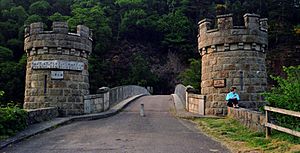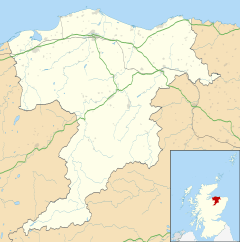Craigellachie, Moray facts for kids
Quick facts for kids Craigellachie
|
|
|---|---|
 The bridge at Craigellachie |
|
| OS grid reference | NJ293452 |
| Council area | |
| Lieutenancy area | |
| Country | Scotland |
| Sovereign state | United Kingdom |
| Post town | ABERLOUR |
| Postcode district | AB38 |
| Police | Grampian |
| Fire | Grampian |
| Ambulance | Scottish |
| EU Parliament | Scotland |
| UK Parliament |
|
| Scottish Parliament |
|
Craigellachie (pronounced "Creag Eileachaidh" in Gaelic) is a small village in Moray, Scotland. It sits where two rivers meet: the River Spey and the River Fiddich. The valley of the River Fiddich gives its name to the famous Glenfiddich whisky. The village is also close to the town of Aberlour.
The name Craigellachie means "rocky hill." It first referred to the cliff above the River Spey where the village is built. People have lived here since at least 1750. Back then, there was a ferry across the Spey river. Today, Craigellachie is an important crossroads for two main roads: the A95 and the A941.
Craigellachie is known for its two whisky distilleries: Craigellachie and The Macallan. It is also home to the Speyside Cooperage, where wooden barrels for whisky are made and repaired.
Contents
The Famous Craigellachie Bridge
One of the most famous sights in Craigellachie is the Craigellachie Bridge. This amazing bridge crosses the River Spey. It was built by a famous engineer named Thomas Telford between 1812 and 1815.
A special plaque on the bridge tells us that its metal parts were made in Wales. Another plaque says the bridge was repaired in 1964 to look like it did when it was first built. You can see this impressive bridge from above or below.
Exploring Craigellachie's Past
People have lived and worked in the Craigellachie area for thousands of years. Archaeologists found evidence of early settlements. They discovered tools from the Middle Bronze Age, around 1681 to 1503 BC.
Later, people built a small village in the Late Bronze Age (around 1050 to 800 BC). There was also a roundhouse from the Middle Iron Age (around 171 BC to AD 51). In the 9th to 12th centuries AD, another small settlement appeared. Archaeologists even found two stone tools from the Mesolithic period, showing people were here very long ago.
Places to See in Craigellachie
Craigellachie has several interesting places to visit. You can find local inns like the Fiddichside Inn and the Highlander Inn. The Craigellachie Hotel is also a well-known spot.
Besides the Craigellachie distillery, The Macallan distillery is very close by. There's also a petrol station in the village with a car wash and a charger for electric cars. A famous nearby landmark is Balvenie Castle, a historic castle you can explore. Many other whisky distilleries are in the area, like Aberlour, Glenfiddich, and The Glenlivet. Many of these offer tours for visitors.
Craigellachie used to have a golf club, which opened in 1898 and closed in the late 1930s.
Craigellachie and the Speyside Way
Craigellachie is an important stop on the Speyside Way. This is a long walking path that stretches from Buckie in the north all the way to Aviemore in the south. It's a great way to explore the beautiful Scottish countryside.
The name Craigellachie is also found far away in British Columbia, Canada. A place there called Craigellachie, British Columbia was named after this Scottish village. It's famous because it's where the last spike of the Canadian Pacific Railway was driven in November 1885. This event completed the first transcontinental railway across Canada.
In Craigellachie, Scotland, there's a dairy farm with many Highland cows. Their milk is used to make a special mature cheddar cheese. The people of the village even have an annual festival to celebrate the farm's long history.


